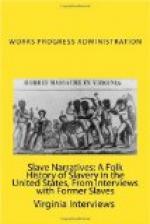“There was a stone building on the farm, it is there today. I saw it this summer while visiting in Virginia. The old jail, it is now used as a garage. Downstairs there were two rooms, one where some of the whipping was done, and the other used by the overseer. Upstairs was used for women and girls. The iron bars have coroded, but you can see where they were. I have never seen slaves sold on the farm, but I have seen them taken away, and brought there. Several times I have seen slaves chained taken away and chained when they came.
“No one on the place was taught to read or write. On Sunday the slaves who wanted to worship would gather at one of the large cabins with one of the overseers present and have their church. After which the overseer would talk. When communion was given the overseer was paid for staying there with half of the collection taken up, some time he would get 25¢. No one could read the Bible. Sandy Jasper, Mr. Ashbie’s coachman was the preacher, he would go to the white Baptist church on Sunday with family and would be better informed because he heard the white preacher.
“Twice each year, after harvest and after New Year’s, the slaves would have their protracted meeting or their revival and after each closing they would baptize in the creek, sometimes in the winter they would break the ice singing Going to the Water or some other hymn of that nature. And at each funeral, the Ashbies would attend the service conducted in the cabin there the deceased was, from there taken to the slave graveyard. A lot dedicated for that purpose, situated about 3/4 of a mile from cabins near a hill.
“There were a number of slaves on our plantation who ran away, some were captured and sold to a Georgia trader, others who were never captured. To intimidate the slaves, the overseers were connected with the patrollers, not only to watch our slaves, but sometimes for the rewards for other slaves who had run away from other plantations. This feature caused a great deal of trouble between the whites and blacks. In 1858 two white men were murdered near Warrenton on the road by colored people, it was never known whether by free people or slaves.
“When work was done the slaves retired to their cabins, some played games, others cooked or rested or did what they wanted. We did not work on Saturdays unless harvest times, then Saturdays were days of work. At other times, on Saturdays you were at leisure to do what you wanted. On Christmas day Mr. Ashbie would call all the slaves together, give them presents, money, after which they spent the day as they liked. On New Year’s day we all were scared, that was the time for selling, buying and trading slaves. We did not know who was to go or come.
“I do not remember of playing any particular game, my sport was fishing. You see I do not believe in ghost stories nor voodooism, I have nothing to say. We boys used to take the horns of a dead cow or bull, cut the end off of it, we could blow it, some having different notes. We could tell who was blowing and from what plantation.




